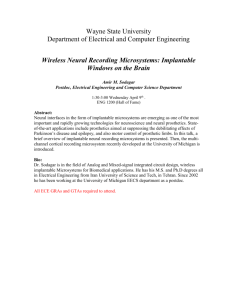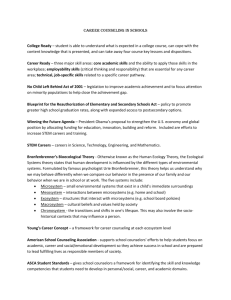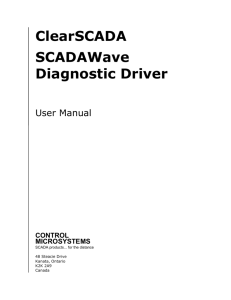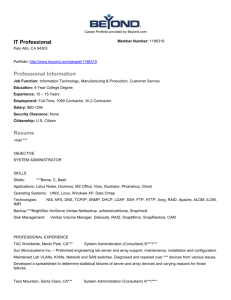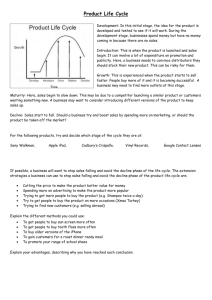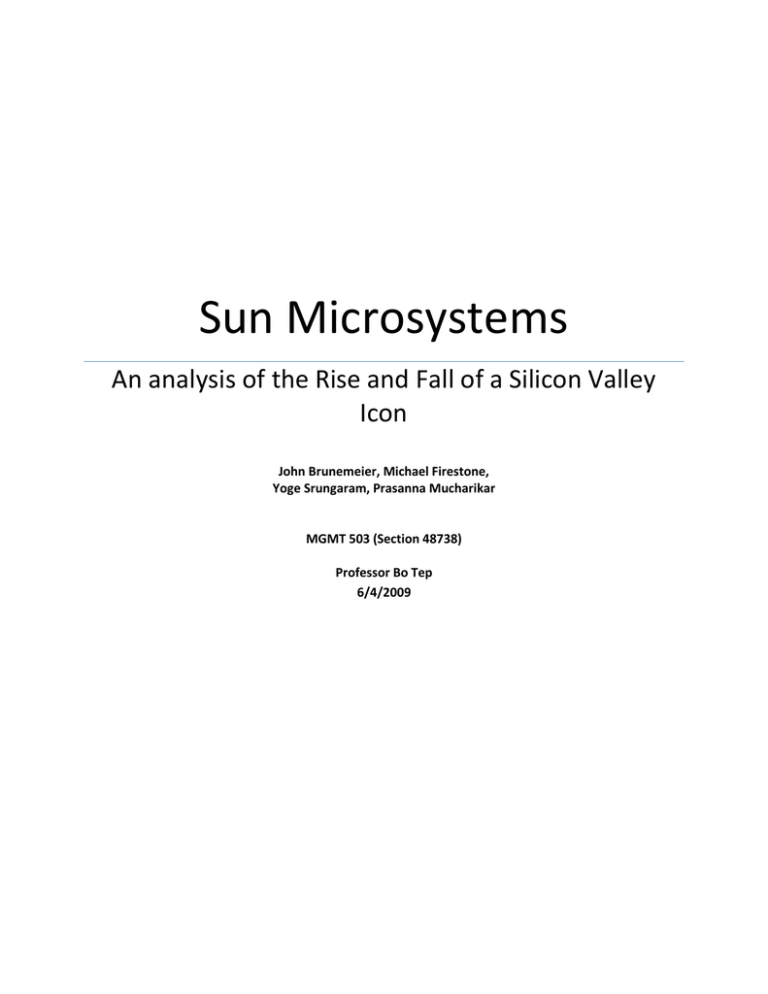
Sun Microsystems
An analysis of the Rise and Fall of a Silicon Valley
Icon
John Brunemeier, Michael Firestone,
Yoge Srungaram, Prasanna Mucharikar
MGMT 503 (Section 48738)
Professor Bo Tep
6/4/2009
Introduction .................................................................................................................................................. 1
Early Years ..................................................................................................................................................... 1
Growth .......................................................................................................................................................... 2
Decline .......................................................................................................................................................... 3
The Dot Com Bust ..................................................................................................................................... 3
Model for Organizational Decline ............................................................................................................. 4
Stage 1: Blinded ........................................................................................................................................ 5
Stage 2: Inaction ....................................................................................................................................... 5
Stage 3: Faulty Actions .............................................................................................................................. 7
Stage 4: Crisis ............................................................................................................................................ 8
Stage 5: Dissolution................................................................................................................................... 9
Conclusion ................................................................................................................................................... 11
References .................................................................................................................................................. 12
2
Introduction
Silicon Valley is rife with stories of start-up companies that did not start and companies
that had good ideas but were not able to bring them to the market in time for success. One of
the most recent failed companies was not a start-up, but one of the Silicon Valley’s greatest
innovators, Sun Microsystems. On April 20, 2009 Oracle acquired Sun for approximately $7.4
billion. This marked the end of a Silicon Valley icon. Sun was tremendously successful in the
1980s and 1990s, but was never able to recover from the Dot Com Bust. Management at Sun
made several attempts to halt the slide toward death, but, in the end, Oracle’s acquisition
effectively dissolved Sun. The remainder of this paper will briefly explain the birth and growth
phases of Sun Microsystems, and, in great detail, explore Sun’s decline phase in the context of
the Weitzel and Jonnson’s Model of Organizational Decline.
Early Years
Like many other Silicon Valley companies, Sun Microsystems started out as a graduate
school project. In 1982, Andy Bechtolsheim, a graduate student at Stanford University, created
a workstation, a new type of computing device that was equipped with high resolution graphics
and allowed file sharing over a network. (Funding Universe, 2009) Although another computer
company had created a workstation one year prior to Bechtolsheim, his workstation was
revolutionary: it used off-the-shelf parts that made it much more affordable. (Funding Universe, 2009)
Sun Microsystems was founded that year by Bechtolsheim and two alumni of the Stanford
Business School, Vinod Khosla and Scott McNealy. Later that year Bill Joy, a computer scientist
from UC Berkeley and co-creator of Unix BSD, was recruited to create the software to power
1
the Sun workstations. (InfoWorld, 2009) With its early workstations Sun-1 and Sun-2, Sun realized $8
million in sales in its first year as a fledgling company.(Funding Universe, 2009)
Growth
The 1980s marked the beginning of Sun’s meteoric rise, and, in the period between
1985 and 1989, Sun was the fastest growing company in the US. Sun’s remarkable growth was
fueled by several products and innovations. In 1984 Sun began successfully licensing its NFS
(Network File System) software that allowed users with different processors to share files over
a network. (Funding Universe 2009) Another Sun innovation came in the 1980s with the design of the
SPARC processor that was built on the simpler but faster RISC architecture. Keeping with its
desire to be an open-source company, Sun later licensed this chip to other manufacturers. The
act of licensing ultimately helped the RISC architecture to become the industry standard for
that time. (Funding Universe, 2009) Sun was very successful in the late eighties and early nineties;
however, as competitors began to produce similar products, many feared that Sun’s period of
rapid growth had come to an end. This fear was proven unfounded when Sun released Java, a
programming language that allowed programmers to write software that was compatible with
any computer of operating system. (Funding Universe, 2009) Sun continued its success for several more
years after the introduction of Java. Unfortunately, the period of decline after the Dot Com
bust started a slide that Sun was unable to reverse.
2
Decline
The Dot Com Bust
In the late 1990s Sun Microsystems took pride in being a key element in the growth of
the commercial side of the world-wide web. Sun sold hardware required to run web servers,
which apart from the human resources, were the only real investment for the mushrooming
dot-com companies. Sun virtually did not have any serious competition in the web server
hardware market as Sun’s SPARC workstations were fast, stable and reliable; just what was
needed to quickly start a new web site. It was no surprise that during the dot com boom, their
marketing slogan was, “We are the dot in dot com.” (Silliconvalley.com, 2009)
Sun would wish that the things had remained the same! With the dot com bubble
bursting, profits peaked in 2000 and revenues followed suit in 2001. In 2002 Sun’s revenues
were down 32% YOY, while SUN lost $628 Million the same year. (Sun Microsystems, 2009)
Figure 1 Sun revenues and profits
3
There were numerous reasons for this sudden decline. To name a few, Sun did not
diversify its product portfolio quickly enough. It was an r-specialist in the web server hardware
business and focused most of its energy on one product. IBM, Sun’s main competitor in this
market, adopted a K-strategy in their PC business, (Jones, 2007, p. 309) and was quick to diversify into
Enterprise software as well as become a service focused company with its IBM Global Services
(IGS) division. IBM’s acquisition of PricewaterhouseCoopers in 2002 (Wikipedia, IBM Global Services, 2009)
was a significant step during the tech downturn years.
The second reason for the decline in revenue was surprisingly Sun’s own products, albeit
second-hand ones. During the tech boom years, many web startups flush with cash, loaded up
on Sun’s servers. As these startups folded their tents in the next few years, the market was
saturated with slightly used high quality Sun equipment. It is widely believed that one of the
main reasons for Sun losing revenue and incurring a loss in 2002 was that Sun had to compete
with its own equipment which was available at throw away prices. (Brodkin, 2009) Not only were
people buying less of Sun’s brand new gear, the presence of the old hardware in the market
was putting pressure on Sun’s margins as well!
Model for Organizational Decline
Weitzel and Jonnson’s Model of Organizational Decline states that there are five stages
of decline, and one would be astonished how easily the events during Sun’s history can be
partitioned into these five different stages. (Jones, 2007, p. 323) With the exception of the final stage,
dissolution, management can take action to reverse the decline. Although Sun did identify
some of the sources of its decline and sought to counteract its slide, Sun met its ultimate fate:
4
de facto dissolution by being acquired by Oracle. The following section will explore Sun’s path
toward dissolution in the context of the Model for Organizational Decline.
Stage 1: Blinded
One of the major technological miss-steps in Sun’s history is believed to be its overreliance on its own SPARC architecture. Sun had become so enamored by its own invention
that it failed to notice the industry-wide transition to Intel’s x86 architecture based systems.
Sun never believed that Intel x86 based machines were ready for the rigors of a life of web
server and by the time Sun noticed this miss-judgment, it was too little, too late. (Brodkin, 2009) It
was 2002, well after the dot com bust, when Sun eventually introduced its general purpose x86
based system. (Wikipedia, Sun Microsystems, 2009)
Stage 2: Inaction
Despite clear signals of deteriorating performance such as decreased sales, profits or
the company falling behind the newer technologies, top management took little action to
correct problems. (Jones, 2007, p.323)
Management decisions at Sun Microsystems about acquisitions and targeting the right
market segment came way too late. For example, Sun Microsystems entered the cloud
computing market by acquiring Q-layer, a cloud computing company only this year (2009). This
acquisition came way too late. In general Sun Microsystems Strategy has been a bit to slow in
moving with the technological innovations happening all around it. (Sun Microsystems website, 2009)
Another scenario where Sun Microsystems was late to react was the PC server business.
Many companies like E-Trade and Google chose to build Web applications based on large
5
numbers of the cheaper PC-class x86-architecture servers running Gnu and Linux, rather than a
smaller number of high-end Sun servers. These companies reported many benefits including
substantially lower expenses and greater flexibility based on the use of open-source software.
(Wikipedia, Sun Microsystems, 2009)
Sun responded quite late by introducing its own lines of PC-class servers to compete
directly in that market, re-launching development of Solaris on the x86 platform and releasing
the open-source Solaris. Again all these changes came way too late. (Wikipedia, Sun Microsystems, 2009)
In 2008, Sun’s product gross margins tumbled to 35.2% from 48% in the first 3 quarters
(down to the lowest level in the company’s history). The lower gross margins reflect a mix-shift
to less profitable low-end servers, as well as increasing pricing pressure. Sun was facing tough
competition from IBM at the high end of its business and from Dell and HP at the low end. (Blog
Barrons, 2008)
Sun created a highly successful programming language called Java. Sun makes money
from Java in three key areas. These include J3ME licenses since every vendor pays an upfront
fee as well as royalties for each Java enabled phone they sell, revenue from Java developer
training programs, and Java tools sold by Sun. When compared to the number of Java users
around the world and related revenues generated are negligible. Sun’s management never
changed it strategy to shore up sales and revenues through Java and related products. (JavaLobby;
Javaworld, 2008)
6
Stage 3: Faulty Actions
If the management fails to halt the decline at the inaction stage, the organization moves
into the faulty action stage. Problems continue to multiply despite corrective action. (Jones, 2007,
p.324)
In this direction, Sun management made several unsuccessful acquisitions in an attempt to
compete in the market place. One such acquisition occurred in September 2000 when Sun
purchased Cobalt Networks for $2 billion in stock, in an attempt to compete with other Linuxbased server vendors. (Wikipedia, Sun Microsystems) In hindsight, the timing couldn’t have been worse
for an Internet-related acquisition, as the internet bubble started to collapse in the last quarter
of 2000. Sun’s Cobalt product line saw some initial success then soon dwindled as Cobalt’s core
ISP market started shrinking dramatically. In December 2003, Sun retired its Cobalt products,
opting at the same time to open-source the underlying software and firmware. (Wikipedia, Cobalt
Networks)
Sun made many other acquisitions which had good intentions, but failed to generate
revenue from them. In the end, Sun gave away much of the acquired technology for free. An
example is MySQL. As quoted by Schwartz “MySQL has approximately 11 m deployments
around the world. The number that actually purchases a service contract is in the thousands.
The number that purchases servers and storage is in the millions.” (Guardian UK, 2008) Sun’s strategy
hasn’t changed at all in spite of its continued losses. Only in the year ending June 2007, Sun
reported its first positive operating income since 2001.(Guardian UK, 2008)
Despite Sun’s commitment to open source, it has a mixed reputation when it comes to
sharing development with the community. A noted external developer, Ben Rockwood who
works on open development said “Sun has done an admirable job with releasing code, but
7
Sun’s history in open development efforts with the free software community has been abysmal.
I refer to it as ‘glasshouse development’ – that is you can look in at what’s going on, but you’re
not part of the action.” (Guardian UK, 2008) To this Schwartz counters saying “People say the same
thing about Linux.” (Guardian UK, 2008) The world knows now which one survived and which the real
open source software is! (Guardian UK, 2008)
Stage 4: Crisis
After the dot-com bubble burst in late 2000 and 2001, Sun entered the crisis stage; Sun
had reached a critical point in its history. "There was just mismanagement," says Enterprise
Strategy Group analyst Brian Babineau, “It was panic and frantic at the end." Typically, only
radical top-down changes to a company’s strategy and structure can stop its rapid decline and
increase its chances of survival. (Jones, 2010, p. 325) For Sun, making the necessary radical changes
turned out to be extremely difficult. There were some people who saw the writing on the wall
earlier than others. After the technology industry collapsed Ed Zander, Sun’s Chief Operating
Officer, had called for big cuts, however, at that time Chief Executive, Scott McNealy resisted.
(Caulfield, 2009)
Sun’s organizational structure and strong culture that looked at technology as a
“holistic product that incorporates chip design, server and systems engineering, and software”
hurt the company’s reorganizations attempts during this crisis stage. Sun's engineers were split
into “competing fiefdoms and fought hard to save pet projects.” This made it hard to make the
necessary cuts. Sun ended up going through a total of nine restructuring efforts since 2002
since it had been unwilling to sacrifice any one piece of its business. (Caulfield, 2009) It let go of “too
few employees, too often” and this also hurt the morale of the remaining employees. (Caulfield,
2009)
8
The company was further damaged in this critical stage by an exodus of talented
employees with innovative ideas. Often in the crisis stage the best managers may already have
left because of fighting in the top-management team. (Jones, 2010, p. 326) In Sun’s case for example,
in 2002 Chief Operating Officer Ed Zander left the company. (Caulfield, 2009) Sun co-founder Andy
Bechtolsheim left Sun for the second time in 2008. Marten Mickos, former MySQL chief
executive and current senior vice president of Sun Microsystems' database group, left Sun after
becoming disaffected with Sun’s large bureaucracy. (Asay, 2009) Furthermore, his departure is
“likely to lead to an exodus among MySQL's deep talent pool.” (Asay, 2009) These departures will
all have lasting negative effects against the company especially for the remaining employees.
Very often a new management team is needed in order to turn around a company. (Jones, 2010, p.
326)
At its peak Sun reported net income of $1.85 billion in fiscal 2000. (Brodkin, A look back
at Sun's rise and fall, 2009, p. 16) By 2001, it only made $927 million. (Brodkin, A look back at Sun's rise and
fall, 2009, p. 16)
The decline turned to losses of $628 million in fiscal 2002 and $2.4 billion in fiscal
2003. (Brodkin, A look back at Sun's rise and fall, 2009, p. 16) Sun has faced increasing pressure from other server
manufacturers using chips from Intel and AMD. Recently IDC reports that Sun has fallen to 4th
place in server market share with 10% of the market, compared to 32% for IBM, 30% for HP,
and 12% for Dell. (CIO Zone, 2009)
Stage 5: Dissolution
Sun’s dwindling server market share and its strategy of offering much of its key software
products for free created a situation where it simply could not survive by itself. Sun had
reached the dissolution stage. Typically when a company reaches the dissolution stage it is
9
unable to recover, and decline is irreversible. (Jones, 2010, p. 327) In Sun’s case, dissolution came in
the form of putting itself up for sale. On Monday, April 20, Oracle agreed to buy Sun for $7.4B.
(The rise and fall of Sun Microsystems, 2009)
There are high expectations (especially by Larry Ellison, Oracle
Corp’s Chief Executive) that Sun’s technologies will have a “big impact on Oracle's future
direction.”
(wolfe, 2009).
Ellison recently confirmed that he does not plan to sell-off Sun’s hardware
business . (Reuters, 2009) Ellison has openly stated his belief that a company that designs both
hardware and software, “can build much better systems than if they only design the software.”
(Reuters, 2009)
Ellison claims that Java and Solaris were the primary reasons for the acquisition. (The
rise and fall of Sun Microsystems, 2009)
Ellison’s comments have the added benefit of reassuring businesses
that may have been hesitant to buy Sun hardware due to uncertainty over its future.
(Reuters, 2009)
Oracle’s president, Safra Catz believes that Oracle can squeeze $1.5B in profit from Sun
products in 2009, and another $2B in 2010. (The rise and fall of Sun Microsystems, 2009)
Most believe that post-acquisition, Sun employees “will find a less laid-back [work]
environment,” working within Oracles’s organizational heirarchy. (Wolfe, 2009) However, Oracle’s
workplace culture is “more focused (laser-focused, in fact) and less roiled by daily rumors about
what's going to happen to the busy.” (Wolfe, 2009) This new culture will benefit the engineers and
developers that are “willing to stand up and fight for their (technology) beliefs . . .”
(Wolfe, 2009)
and in turn ultimately benefit Sun’ new owner Oracle. The dissolution phase has eclipsed Sun’s
ability to function as a profitable independent entity. It is now up to its new owner Oracle to
capitalize on Sun’s powerful hardware and popular software platforms.
10
Conclusion
Sun made three major mistakes. First, it simply had not accepted the fact that the
industry was transitioning to lower cost Intel based x86 processors. Sun maintained its focus on
pushing its high-end proprietary processors and found itself unable to compete. Second, Sun
attempted to acquire its way out of the problem. It executed several expensive acquisitions
extremely poorly. In desperation, Sun tried to compete in many different hardware and
software markets but was not able to become a market leader. Lastly, Sun was unable to
monetize its key products. Sun’s Java software became the industry standard for platform
independent software; however, it was not able to capitalize on the software’s popularity
because it was given away for free. Several other firms created software to aid development of
Java applications and realized excellent returns. Sun’s idealistic philosophy of free, open-source
software contributed to its demise. It is hard to imagine that a company that began so
successfully and contributed so profoundly to technology would allow itself to lose focus,
decline and ultimately be dissolved. Sun’s decline fits very well with the Weitzel and Jonnsson
model, and it is unfortunate that management at Sun could not recognize the stages of decline
and take timely corrective action. Within twenty five years, Sun Microsystems experience birth,
growth, decline and death; in 2009 the Sun finally set.
11
References
Brodkin, J. (2009, April 29). A look back at Sun's rise and fall. NetworkWorld , pp. 1,16.
Jones, G. R. (2007). Organizational theory, Design and Change. Upper Saddle River: Pearson Prentice
Hall.
Silliconvalley.com. (2009, March 18). Sun Microsystems a longtime leader in innovation. Retrieved May
30, 2009, from Silliconvalley.com: http://www.siliconvalley.com/ci_11945023?source=most_viewed
Sun Microsystems. (2009). Sun Microsystems - Investors relations : Financial Press Release. Retrieved
May 30, 2009, from Sun Microsystems:
http://www.sun.com/aboutsun/investor/earnings_releases/earnings_pr.jsp
Wikipedia. (2009, May 17). IBM Global Services. Retrieved May 30, 2009, from Wikipedia:
http://en.wikipedia.org/wiki/IBM_Global_Services
Wikipedia. (2009, May 28). Sun Microsystems. Retrieved May 30, 2009, from Wikipedia:
http://en.wikipedia.org/wiki/Sun_Microsystems
Funding Universe (2009) Sun Microsystems Inc. Retrieved May 28, 2009
Website: http://www.fundinguniverse.com/company-histories/Sun-Microsystems-Inc-CompanyHistory.html
InfoWorld (2009) The Rise and Fall of Sun Microsystems . Retrieved May 26, 2009
Guardian UK (2008). Open Source Sun Microsystems. Retrieved May 27, 2009
Website: http://www.guardian.co.uk/technology/2008/feb/21/opensource.sunmicrosystems
Wikipedia. (2009, May 30). Cobalt Networks. Retrieved May 30, 2009, from Wikipedia:
Website:http://en.wikipedia.org/wiki/Cobalt_Networks
JavaWorld (2006). Sun Microsystems. Retrieved May 27, 2009
Website: http://www.javaworld.com/javaworld/jw-06-2006/jw-0626-iw-sun.html
Javalobby (2006). Sun Microsystems. Retrieved May 27, 2009
Website: http://www.javalobby.org/java/forums/t75002.html
Barrons Blog (2008). Sun Microsystems. Retrieved May 30, 2009
Website: http://blogs.barrons.com/techtraderdaily/2008/10/31/sun-no-guidance-no-restructuring-noturnaround/
Sun Microsystems. (2009). Sun Microsystems – Press Room Retrieved May 30, 2009
Website: http://www.sun.com/aboutsun/pr/2009-01/sunflash.20090107.1.xml
Asay, M. (2009, February 6). Marten Mickos to Leave Sun in reorg. Retrieved May 29, 2009, from CNET
News: http://news.cnet.com/8301-13505_3-10158335-16.html
12
Brodkin, J. (2009, April 27). A look back at Sun's rise and fall. Network World , pp. 1, 16.
Caulfield, A. G. (2009, April 7). Sun's Six Biggest Mistakes . Retrieved May 29, 2009, from Forbes.com:
http://www.forbes.com/2009/04/06/sun-microsystems-enterprise-technology-enterprise-tech-sun.html
CIO Zone. (2009). Sun Microsystems Burned Hot Before Fading . Retrieved May 29, 2009, from CIO Zone
Network for IT Leadership: http://www.ciozone.com/index.php/Editorial-Research/Sun-MicrosystemsBurned-Hot-Before-Fading/10.html
Jones, G. R. (2010). Organizational Theory, Design, and Change 6th Edition. Upper Saddle River: Prentice
Hall.
The rise and fall of Sun Microsystems. (2009, April 24). Retrieved May 29, 2009, from InfoWorld.com:
http://www.infoworld.com/t/tech-industry-analysis/rise-and-fall-sun-microsystems914&current=14&last=1#slideshowTop
Reuters. (2009, May 8). Oracle Won't Divest Sun's Hardware Business . Retrieved May 29, 2009, from
Information Week:
http://www.informationweek.com/news/hardware/unix_linux/showArticle.jhtml?articleID=217300827
Wolfe, A. (2009, April 21). Sun's Deep Tech Bench Is Biggest Asset For Oracle. Retrieved May 29, 2009,
from Information Week:
http://www.informationweek.com/blog/main/archives/2009/04/suns_deep_tech.html;jsessionid=YE0F
NDHM00WEQQSNDLPCKH0CJUNN2JVN?print=true
13

